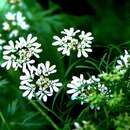Coriander (
Coriandrum sativum), also known as Cilantro, is a slender, solid-stemmed annual reaching 60 cm in height. The upper leaves are divided into narrow linear segments, the lower leaves into broad leaflets. The small flowers are white or pink. The middle flowers in each
umbel are infertile, while the outer flowers are slightly larger and fertile. The globose fruits are around 3 mm in diameter, ridged, and yellowish brown. Coriander likely originated in the eastern Mediterranean region and archaological evidence indicates it was already being used in the
Neolithic period in Israel. It was used by both the Greeks and Romans. The Romans brought Coriander to northwestern Europe, including Britain. It also reached India and China. When crushed, all parts of the Coriander plant give off an odor reminiscent of stink bugs (family Pentatomidae). The pungent leaves are used in a wide range of cuisines around the world. When the seeds are dried, this odor is lost and replaced with a mild aromatic flavor. Coriander is used in curries, meat dishes, bread, sweets, and alcoholic drinks. Major world producers include Morocco, India Pakistan, Romania, and the former Soviet Union, but Coriander is grown in many other countries as well (e.g., Iran, Turkey, Egypt, and Israel in the Middle East; China, Burma, and Thailand in Asia; Poland, Bulgaria, Hungary, France, and the Netherlands in Europe; and the United States, Canada, Argentina, and Mexico in the Americas) (Alberta, Canada Agriculture and Rural Development Coriander
AGRIFACTS Fact Sheet, updated December 2008). The fresh leaves of the plant are considered an extremely pleasant flavoring by some people, but repulsive by others. Cilanto-haters seem to be far more frequent in some cultures than others and some limited evidence suggests there may be a significant genetic component to these taste responses. (Vaughan and Geissler 1997)

